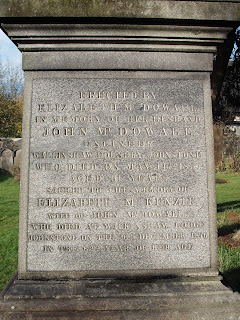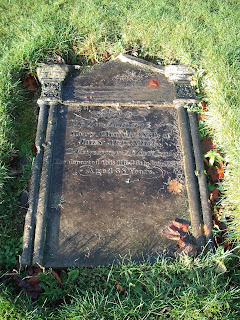The octagonal-shaped kirks we saw in nearby Lochwinnoch may have been influenced by this one recently (c.1790) built 6-7 miles away in the mushrooming new mill town of Johnstone. The kirk was first built as a 'chapel-of-ease' (stock term) within an area until 1865 still classed as within the old boundaries of Paisley Abbey Parish - although Johnstone was classified as a burgh from 1857.
To the rear of the church, sheltering behind trees, this obelisk memorial testifies to extended McDowall family influence (see previous entry: Lochwinnoch) - stretching to Glasgow and far beyond. John McDowall - 'Engineer' as detailed by the close-up of the inscription - began an engineering business in Dimity Street in 1823. In economic terms, Johnstone was by this point moving from a textile to an engineering base.
Below: on the boundary wall, an early 19th century wall plaque indicating a plot purchased for family 'use' - here by one John Stevenson,"Boardsmith" and his wife Agness Riddell, touchingly (though quite commonly)for their children who died in infancy.
Yards away, another (note the lair number) memorialising James Colville's wife, Margaret Erskine.
On the opposite wall (pictured below), an impressive memorial blending mostly Gothic with some Classical features. Beneath a carving of Christ is the motto 'God is our Refuge and our Strength.' It commemorates Robert Walker (d.1845), 'Joiner, Elderslie (an adjoining village), his wife Elizabeth Rowan, and their family.
Below: of these two stones set against a plinth-like ashlar frame, the inscription of that on the left-hand picture side is now obliterated. From records we know it memorialised the Rev. Alexander Telford, minister of the parish from 1807 to his death in 1840, aged 58. His wife's name, Helen Gray (d.1854) survives on the block beneath. The stone on the right with the still legible epitaph commemorates the Rev. William Gaff, minister for 20 years, and his wife Margaret Leggat. Dying suddenly aged 46, he left a "devoted and lamenting congregation"; and likewise it seems distraught wife, who died only 3 days later.

Above, this unusual memorial has a marble plaque but is otherwise made of iron, quite ornate and topped by the ubiquitous funerary urn. Not inappropriately, it commemorates the engineer Hugh Donald (d.1867) - the family had begun operations in Johnstone back in 1815 - having been erected by his wife, Catherine Shearer.
Below: now laid flat, another Classical design records Mary Clement 'Wife of John MacNiel, Manager, Johnstone', who died in 183(?) aged 38.
Above, this Classically styled wall memorial, framed by Ionic pilasters below a quaintly decorated frieze, commemorates departed sons - each in turn (thirteen years apart) named Thomas and dying aged 3 (1844) and 13 (1867) respectively - and, in time, their by-then elderly parents (David Jaffrey and Mary Mills).
None of the town's old Seceder kirks have survived. Typically here a Burgher church appeared in the new town before a parish one - several of its ministers are buried here in the parish graveyard. An Episcopal Church of 1874 stands nearby, built to serve mostly incoming workers from England and Ireland it is still in-use by local Anglicans.
Below: view of the Church across Ludovic Square.
For further reading on Johnstone - a place barely mentioned in the 19th century Statistical Accounts due to its late parish status - see: Discover Johnstone, Moira Burgess (Renfrew District Council, 1992); Johnstone High Parish Church 1792-1992, Patricia M. Thomson (Johnstone, 1991); and for the graveyard the standard work Monumental Inscriptions (pre-1855) in Renfrewshire, Mitchell & Mitchell (Scottish Genealogy Society, 1969) 167-178. A local museum charting Johnstone's growth is housed within a nearby supermarket complex (at time of writing Morrisons); manned by volunteers it currently opens 3-4 days per week.










Renfrewshire Family History Society have all the burial data and ALL monumental inscriptions for Johnstone churchyard, not just pre 1855.
ReplyDelete